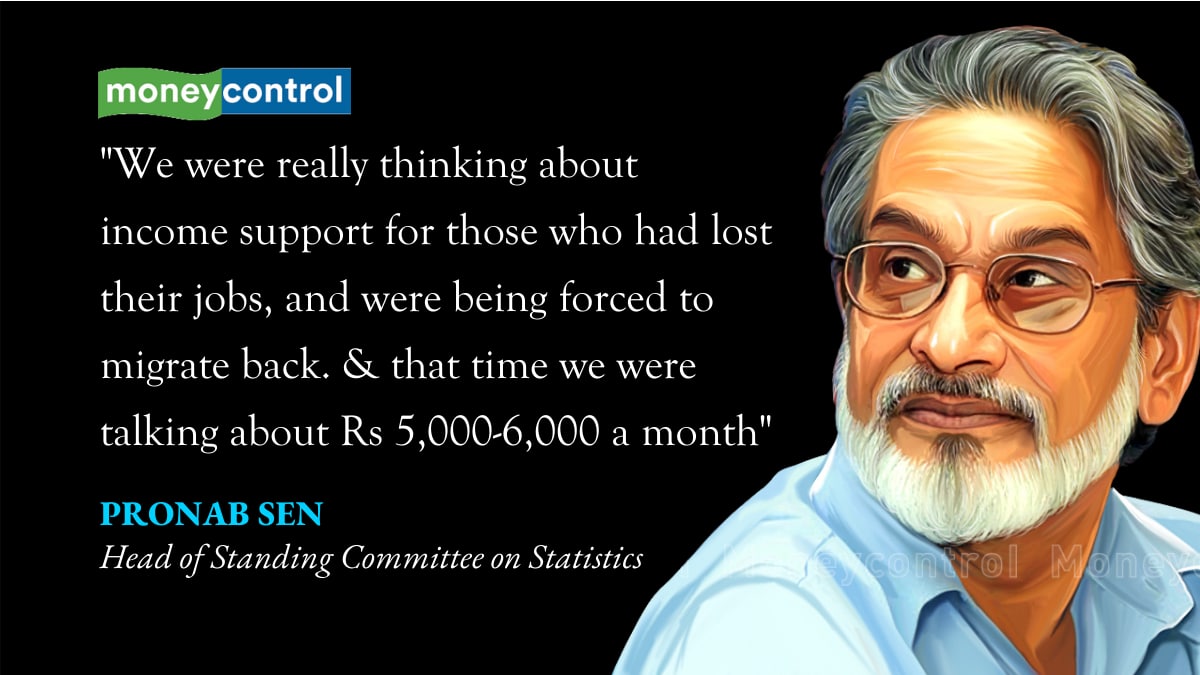Representational picture
The government held discussions to consider providing a minimum income support programme designed to help India’s poorest households who bore the brunt of the pandemic, said a top official.
These discussions held last year concerned a temporary income support of around Rs 5,000-6,000 per month for the urban and rural poor who lost their livelihoods in the nationwide lockdown last year, said Pronab Sen, the head of a federal standing committee to overhaul India’s economic statistics and data collection.
“We were really thinking about income support for those who had lost their jobs, and were being forced to migrate back,” Sen told Moneycontrol in an interview on June 18. Sen was India's first Chief Statistician.
Sen said the discussions centred on a basic income that would be temporary. When asked if by ‘we’ he meant internal discussions in the government, Sen answered in the affirmative.
The idea of a basic income programme has been floated for some years now in the realm of policymaking both as a solution to poverty and to fix the flaws in passing subsidies to the deserving poor. Consensus, as it happens on such matters, has eluded economists as some supported income just for farmers while others favoured a wider programme for the entire population.
Yet others such as Arvind Subramanian, the former chief economic adviser, have advocated a quasi-universal basic rural income (QUBRI) of Rs 18,000 per year to each rural household, except those which are "demonstrably well-off". At Rs 1,500 a month, covering 75 percent of the rural population, that would have cost an estimated Rs 2.64 lakh crore, or a total fiscal cost of about 1.3 percent of the GDP.
India’s gross domestic product crashed by 24.4 percent in the April-June 2020-21 quarter, when the country was under a nationwide lockdown. As per the Centre for Monitoring Indian Economy (CMIE), some 121 million jobs were lost, the highest ever monthly job loss on record since it started compiling employment data.
Out of the 121 million jobs lost, some 91 million were daily wage labourers and workers in the unorganised sector, CMIE had estimated. In April 2020, unemployment rate touched a record high of 23.52 percent, dropped to 21.73 percent in May 2020 and 10.18 percent in June 2020, it said.
While the April 2020 unemployment numbers reduced sharply post-lockdown, even providing Rs 6,000 per month to half of the 91 million estimated informal sector jobs lost would have cost the exchequer around Rs 27,000 crore in a financially stretched year.

Data Issues
But the government stopped short of pursuing the programme. Sen said the exercise was not taken forward due to issues with the data on those in unorganied sector who had lost their jobs, data on dormant Jan-Dhan accounts and lack of data on how many people were supported by any single account holder.
“Getting the funds out to people, while making sure it's getting to the right person is not a trivial job. We know that Jan-Dhan accounts do exist, but how many of them are dormant? And we really don't know the number of household members each Jan-Dhan account holder supports. All of that information that has to be generated,” Sen said.
The last publicly available data on dormant Jan-Dhan accounts is from January 2020, when the finance ministry, in a reply to Lok Sabha, said a little less than 20 percent such accounts were dormant. There existed 42.47 crore Jan-Dhan accounts in total as on June 6, 2021.
As per the definition by the Reserve Bank of India, any Jan-Dhan account is classified as dormant if there has been no activity for two years.
In 2020, countries worldwide resorted to cash transfer to help the vulnerable citizens cope up with the economic turmoil posed by the pandemic. Canada, for instance provided $1,400 per month to those who lost income due to the COVID-19 pandemic. In the USA, the citizens were provided with checks of up to $1200 . South Korea issued cash transfers of $820 for its citizens and Japan announced cash transfers of $931 per person.
Need for income support now
As India emerges out of the second wave amid fears of a third one, a number of prominent economists and industry bodies like the Federation of Indian Chambers of Commerce and Industry have asked the government to provide minimum income support to India’s poor, in order to spur demand.
At the peak of the second wave in May, over 15 million jobs were lost during May 2021, CMIE data says. The unemployment rate was in double digits last month, for only the second time after last year's lockdown.
In an interview, Nomura Chief Economist Sonal Verma had told Moneycontrol that a mechanism needs to be put in place to provide temporary income support to the poor. Others like Niti Aayog Vice-Chairman Rajiv Kumar and Morgan Stanley Chief India Economist Upasana Chachra have been on the other side of that debate.
“I contest the view of those who say that we require at this time a direct income transfer, because all that income transfer would result only in higher bank deposits, and not in higher spending on the consumption, and that is what we don't need,” Kumar told Moneycontrol.
Pronab Sen’s own view is that if the Centre does decide on an income support mechanism, it has to start that work as soon as possible.
“If the government is serious about it, then they have to take the decision now. And the population census has to be reconfigured, to be able to get the information that is necessary to be able to implement a universal basic income,” he said.
“The appropriate time to do this kind of an exercise and this sort of preparatory work is really to meld it into the population census,” Sen said.
Work on the census, which was delayed due to the pandemic, is expected to begin later this year.